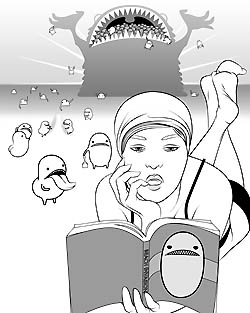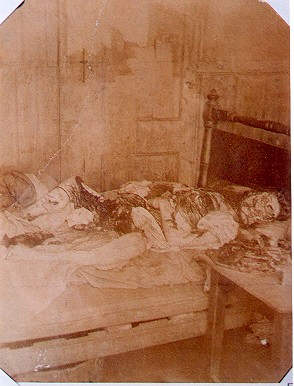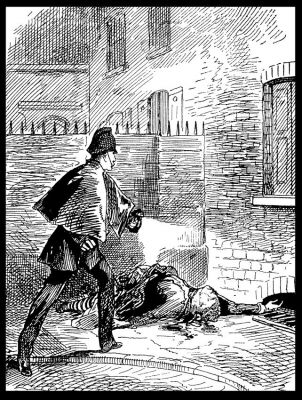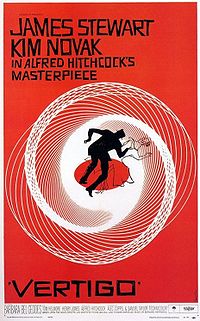|
Irvine Valley College: Online Literature Study of the School of Humanities and Languages Literature 110 - Popular Literature Spring 2013 - Ticket #62740 // Marjorie Coverley Luesebrink, MFA, Instructor
Unit 4: Enduring Crimes The Lodger, Marie Belloc Lowndes
One of Jack the Ripper's Victims
"Readable" Characters Robert and Ellen Bunting not only give us the cozy (but genteel shabby) parlor for the story to take place and provide the concrete details of intimacy, they are also our "readable" characters. In a Crime Novel such as this, where the center is not the intrepid detective, we usually are encouraged to identify with and follow characters who have a certain important qualities. The first of these is a kind of credulity. The reader knows he/she is reading a Crime Novel, so something bad has got to be fixing to happen, but we must believe that the main character or characters are blissfully unaware of what is ahead - at least at the very beginning. One way of creating a naive character is to have that character be of average or above-average intelligence, but not brilliant. In placing the Buntings "in service", Lowndes signals that they are not overeducated or so brilliant that they could have figured out a different life. They are both observant to a point, and careful - but they have a discernable lack of sophistication. Another way of creating characters who might let early clues go unnoticed is to give them something else to worry about. That is also the case for the Buntings. They are worried about money and about making sure they can rent their room out. This distraction keeps them from being overly suspicious at the start - and so we, the knowing audience - can "read" them as genuine people that might be likely to find themselves confronted with crime, all unwitting!
Discovering a Victim of the Ripper
Patterned Structure The structural patterns of the Genre Crime Novel naturally are more numerous and complex than those of the sub-Genre of Detective stories. Depending on whether the novel is an International Thriller or a Legal Drama or any one of the other categories, the pattern will be determined by the necessities of the story elements. In a Psychological Thriller, such as *The Lodger* there are some very prevalent techniques that we can identify. In the Detective/Mystery story, we have a multitude of shady characters, any one of which might possibly be the murderer/criminal. The progress of the plot takes us through the process of eliminating one after another of these suspects as clues and information about the crime surfaces. In the Psychological Thriller, we don't necessarily have multiple suspects, rather, the suspense arises as the creepy evidence mounts up. The trick for the writer (in the opening chapters) is to pile up as many unnerving events or details as possible without the main characters having to conclude that there is something really, really wrong. Note the way that happens in this novel! Each of the seemingly unlikely actions of the mysterious lodger can be explained away with some kind of excuse. And Ellen is a mistress of making these - until she can't any longer! Robert, constitutionally less suspicious, takes even longer to add up the clues. The latter part of the Psychological Thriller revolves around what the characters are going to do in response to the threat. Quite often, they have a hard time convincing anyone else that the threat is real - especially since each detail on its own is relatively dismissible! Then, when there is a kind of critical mass of agreement - the characters often find that they are dealing with something that is far beyond their power to subdue or even quite understand. How they grapple with this fact brings us to the denouement (this is an important concept to know and be able to use - so please read the linked material!).
London's Whitechapel district in the 1900's Reassuring Plot It's safe to say that of all the varieties of Crime Novel, the Psychological Thriller usually has the most unsettling of plot structures. It is a strange aspect of human nature that in this kind of novel, where the threat is often unseen and unquantifiable, the reader can carry away a greater "scare" than from any other kind of concrete crime where the real criminal goes to a real jail and so forth! [In this sense, the Psychological Thriller is much like a Horror Story, and we find a fair amount of genre-crossing among the writers in these fields.] So what aspects of the plots of these stories serve to reassure us, just a little bit, so that we are not indelibly set against reading the genre ever again? Now is probably a good time to review a couple of other PsyThrill plots that might give us a perspective! here is a summary of the plot of *Rosemary's Baby* (1968) [from the Internet Movie Database] Rosemary and Guy Woodhouse move into an apartment in a building with a bad reputation. They discover that their neighbours are a very friendly elderly couple named Roman and Minnie Castevet, and Guy begins to spend a lot of time with them. Strange things start to happen: a woman Rosemary meets in the washroom dies a mysterious death, Rosemary has strange dreams and hears strange noises and Guy becomes remote and distant. Then Rosemary falls pregnant and begins to suspect that her neighbours have special plans for her child. Written by Goth {brooks@odie.ee.wits.ac.za} [unfortunately, this link is 404 - no longer active - ah, the elusive Web!]
Mia Farrow in *Rosemary's Baby* After moving into a creepy old apartment in Manhattan with her husband Guy, Rosemary Woodhouse begins to experience odd, unpleasant things happening to her. Guy becomes enchanted with their nosy neighbors, Minnie and Roman Castevet, after the older couple's ward commits suicide. Then Rosemary gets pregnant after a bad dream in which a horrible creature makes love to her. A caring Minnie keeps giving her some weird concoction for the pregnancy and Rosemary doesn't feel at all well. The only solution is, as the tag-line says, to "pray for Rosemary's baby." Written by alfiehitchie.[unfortunately, this link is 404 - no longer active - ah, the elusive Web!]
Mia Farrow and John Cassavetes in *Rosemary's Baby* and a reader comment from the site: Given the film's POV, the story is rather subjective. Its interpretation is based on Rosemary's perceptions, images, and fears. One could explain that Rosemary suffers from delusions. Or, alternately, one could explain that what happens is real. *Rosemary's Baby* uses one of the traditional methods of softening the terror - and that is to have an ambiguous ending. It's not comforting, really, but we are reassured that there could be a real-life explanation that would leave our assumptions about reality and sanity intact! Movie poster from Hitchcock's *Vertigo* Another well-known Psychological Thriller is Hitchcock's *Vertigo.* This movie was based on a novel, *D'entre les morts* ("Cold Sweat: From Among the Dead") by Boileau-Narcejac, two collaborating French writers. Their works are often referred to a "locked-room mysteries" - so it is easy to see how they might be adapted to chilling thrillers! The story follows the adventures of a retired policeman who falls in love with a mysterious woman he has been hired to follow. Right there, of course, we have the main elements of the detective story - but this tale moves almost immediately from fear of physical danger to mental threat - and thereby hangs the tale. The Wikipedia summary of the plot is excellent - so take this link! here is the very end: Judy pleads to Scottie that she does love him, and his anger abates. The two embrace and then, suddenly, a shadowy figure appears at the top of the stairs. Judy, frightened, backs away from the approaching shadow and steps backwards off the tower ledge, plunging to her death. The figure, a nun, whispers, "God, have mercy", and rings the tower bell as Scottie stares down at Judy's fallen body; the emotional shock has cured his vertigo.
Scene from *Vertigo* Well, Scottie's vertigo is cured. But the resolution of the psychological terror has been accomplished in a different way. Because Judy dies in a very explainable and real-material fashion, the immediate threat is eliminated from the imaginary world-as-we-know it. This is a second technique for "calming" the plot at the end of a thriller like this: although the central phenomenon is not quite explained, the person who embodies it dies in a normal way and so takes the threat out of the realm of possibility for a while. I would be eager to see other examples that you are familiar with - you are encouraged to post these on the discussion list!
Continue to Section "Clear-cut Value System" (4c) Mythological and Folk Referents
Crime: while "detective" fiction keeps its discovery process right in the Point of View of the Detective, Crime Fiction, an umbrella category for all fiction that involves crime, often tells the story from a different point of view with perhaps an unusual kind of narrator (innocent bystander, curious reporter, would-be-victim). Some of our detective writers (such as P.D. James) also write other kinds of Crime Fiction. But the genre has a wide variety of approaches. Marie Belloc Lowndes, of course, is one writer we will become familiar with as we follow her treatment of Jack the Ripper - her fiction could be included in a sub-category of "psychological thriller," as well. but you also might like to sample: Edgar Allen Poe: Poe's classic tales of live incarceration and mystery are full of criminal (and psychological) detail! A list of the 100 best mystery writers will give you an idea of the roll call of these writers! From The Mystery Writers of America.
Marjorie Coverley Luesebrink: write to me with questions!
Marjorie Coverley Luesebrink, MFA, your Instructor, is a Professor of English in the School of Humanities and Languages, Irvine Valley College, Irvine, California. See Online writing at Home Page. |
| MENUBAR: About Your Class // Class Syllabus // Lecture Notes // Reading List // Recommended Reading // Assignments // Grading Policies // Contact Your Instructor // Announcements // Discussion |







